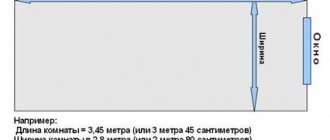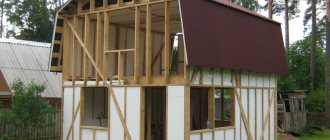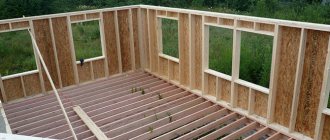Frame houses are most often built using a pile-screw foundation. This technology saves time on foundation installation and does not require excavation work. What should be the distance between screw piles for a frame house? What subtleties do you need to know before starting work? Let's try to figure it out.
Features of a pile foundation
This type of foundation is not suitable for the construction of buildings made of heavy materials (brick, concrete, etc.). It is intended exclusively for the construction of light structures, such as frames.
The design is easy to install. The work is carried out according to the following algorithm:
- Selection and cleaning of the site. Trees, bushes and grass are removed. There should be no communications in the work area.
- Marking the territory. This is necessary for the most accurate installation of piles. The marking is carried out according to a pre-prepared project, where the location of each support is indicated in detail. The maximum permissible deviation from the design is 2 cm.
- Installation of piles. According to the markings, a small recess is made for each pile - 15-20 cm, so that the support is easier to install. We install the pile and screw it in.
- Installation of piles is painstaking work. To do this you need to involve 3-4 people. First of all, the support needs to be assembled: in the upper part of the piles there is a special hole into which a crowbar (3 cm in diameter) is inserted. A lever is then mounted on it - it helps to simplify the process of screwing in the support.
- A pipe 3-3.5 m long is used as a lever. The longer the lever, the easier the support rotates. In addition, it is important that the piles enter the ground smoothly. For this, a building level is used, which is applied to the post while screwing.
- Next, we place the support in the prepared recess and begin to screw it in. To do this, two people grab the lever on both sides of the support and move in a direction against the axis. In one full rotation, the pile plunges into the ground approximately 20 cm.
Important! If the pile enters the ground unevenly, it must be leveled.
Therefore, the level of entry should be monitored throughout the entire process. It is important to remember that the deeper the support is immersed in the ground, the more difficult it is to level.
It happens that the “first” steps are difficult, and the screw does not want to turn. In such cases, the recess for support increases by 10-15 cm, and some kind of weight is hung on the levers as an additional vertical load. When the support rotates easily, the load can be removed.
Area distribution
To meet the requirements for clearance, uniform load distribution, and optimal quantity, there are various arrangement options:
- In rows. It is used in a pile-and-tape design. In 1 row they retreat in increments of 1.33 m, in 2 rows - 2.67 m;
- Chess. For pile-grillage foundation. The benefit is that the required size is laid out diagonally. The number of points inside the same perimeter increases.
In order to maintain the symmetry of the location, the number of piles is changed only in the direction of increase. All roundings in calculations are also made upward. For a different standard size of supports, a complete recalculation of the entire foundation is made.
If a structure is made by pouring concrete to form a pillar, the surrounding soil is squeezed out. You cannot pour a nest of the next base closer than 1.5 m when the solution of the adjacent mold has not yet reached 50% strength. In this case, the work is done through one rack.
We recommend watching a video on how to make a pile diagram yourself.
Working with piles
After installation of screw piles, additional work is carried out. First of all, you should make sure that all supports are installed level. There should be at least 60 cm from the ground to the zero level of the house. We align all the piles so that they are in the same plane. For this you can use a grinder.
Next, the supports are concreted to give them strength. This will eliminate the possibility of tilting and deformation of the future foundation. It is also necessary to expel air from the cavities so that the foundation does not collapse in the future.
The mixture is poured into the internal void of the pile, it is also necessary to lay reinforcement, this will give the structure reliability. For this, a cement-sand mixture is prepared. Its consumption is 35 kg per 1 pile.
The final stage of mounting the supports is to weld the ends. After this, timber tying is performed. If you use a channel instead of a beam, then you can do without the heads. This will help you save a lot.
Working with a pile-screw foundation excludes the following actions:
- Adjusting the piles to the same level during screwing. This work is carried out after the installation of all supports is completed, otherwise it may provoke subsidence of the foundation in the future;
- Lengthening unevenly screwed in piles;
- Installation of supports less than 1.5 m into the ground;
- Creating preparatory holes for supports in the ground deeper than 50 cm;
It is impossible to install supports with damaged coating. This will lead to corrosion and destruction of the piles.
Minimum and maximum value
The smallest step value depends on the thickness of the soil , which is compacted by the blades around the pile during the process of screwing it in.
According to the standards from SNiP, the minimum step is taken equal to three diameters of the supporting elements, and the maximum – six diameters.
The exceptions are the following cases:
The technology for installing screw piles involves installing supporting elements at an angle. Then the minimum step will be 1.5Ø.- In areas with a large slope, the distance is taken as minimal as possible.
- When building on sufficiently dense and stable soils, the gap between the supports can be equal to eight diameters. The same range is suitable for the construction of light buildings that will be used to a minimum.
- On sites with a high sand content, a step of four diameters is considered optimal. The distance is reduced if the soil is excessively compacted.
Determination of soil bearing capacity
To install a pile-screw foundation, you need to know about the bearing capacity of the soil. The design of the house, including the foundation, is created on the basis of this data. Finding out the structure is not difficult; to do this, you can look on the Internet or ask your neighbors.
Even after finding out this information, it is better to check the soil on the site yourself. To do this, you need to take an old fishing drill and drill a hole in the far corner of the area. This will help to clearly see the condition of the soil: its moisture content, the depth of the horizons, etc.
To check, it is recommended to drill a hole below the expected immersion level of the piles. This will help you become familiar with the qualities of the lower soil horizons, which play the main role in fixing the supports.
Influence of the support layer
Installing a house on screw, bored, or driven posts has the goal, in addition to distributing the load, to achieve denser layers on which to rest. You can independently dig test shafts on the site to determine their depth. Quantity – at least 2. If the layer is inclined, with ledges, more is needed to make the picture clearer.
When calculating the load, soil characteristics are taken from the reference book. In case of a complex combination of conditions, an analysis of the control pile is performed.
The type and method of installation affect the number of foundation support points and the load distribution area. Hanging elements work along the side surface. Screw pipes create a compaction of the material underneath. Bored supports have a base wider than the column.
The design of pile foundations in soil conditions of type II in terms of subsidence should be carried out by specialized organizations.
All of them pass below the freezing level in order to create resistance to the movement of the upper layers of the earth during heaving.
Placement of supports in plan
Correct placement of piles is necessary to maintain the integrity of the frame house and avoid subsidence. This is especially true for complex projects: projects of two-story houses, a building with irregularly shaped walls, etc. The main rule: the load must be distributed evenly.
The location of house supports is of four types:
- Single. The piles are located at an equal distance from one another at the corners of the building, under the load-bearing walls, and under the vertical posts of the frame;
- Tape. This type of pile-screw foundation can withstand higher loads. The supports are located as with a single type of foundation, only the step between them is shortened;
- Bush. This implies a chaotic placement of supports under the foundation of the house. They are mounted in clusters, with most piles located in areas with the highest load (for example, under a room with heavy equipment). Under such conditions, the step between the supports does not matter, the main thing is that they are along the entire perimeter of the slab;
- Continuous (in other words, pile field). This type of foundation is relevant for areas with unstable ground cover and for heavy frame buildings. The piles are arranged in a grid around the entire perimeter of the building. The maximum step is 1 m.
Important! The most common types of pile-screw foundations are strip and single. They are provided for in the designs of private houses and small buildings.
Materials
As a standard, this is often timber, brick, cinder blocks, if we are talking about building a house.
An example of matching pile distances for a one-story private house made of different materials.
| Material | Distance between piles |
| timber | 3 meters |
| Cinder blocks | 2.5 meters |
| Brick | 2 meters |
The heavier the building material, the shorter the distance should be between the piles. It is logical that this distance also depends on the number of storeys of the building. An additional floor will also shorten the distance.
Calculation features
Calculating the correct distance between the supports is important for the following reasons: if the supports are too far apart, the building may settle; a small distance between the piles will significantly increase the financial costs of construction. Professional builders recommend taking into account when making calculations:
- Weight of the frame structure as a whole;
- A lot of furniture, equipment, communication systems;
- Safety factor;
- Properties of the piles themselves;
- Load from wind and snow;
- Soil stability.
The calculation also takes into account such indicators as:
- Payload. It is determined by the provisions of SNiP (building codes and regulations);
- Snow load. It is individual for each region, so you need to find it specifically for your area;
- The standard safety factor is always used - 1.1-1.25.
As soon as the calculations are carried out, it is necessary to record the obtained data. For this, a diagram is drawn. It clearly indicates the location of each individual pile on the foundation plan. This will simplify the distribution of supports directly during work. Whatever the result of the calculations, the columns must be located at the corners of the building, in the area where the load-bearing structures meet. The remaining supports are placed under the floor joists of the future house; they need to be distributed evenly.
Types of piles used
What distance between piles to choose for a frame house largely depends on the type of piles. The following piles are used:
- Round or polygonal cross-section.
- Hollow, solid, solid, composite.
- Metal, concrete, reinforced concrete.
- With conical, sliding or screw nozzles.
Typically, standing piles are installed for a frame house, reaching dense layers of soil. The load from the house is redistributed evenly onto the ground, the structure is stable and can withstand seasonal fluctuations in the level of surface layers of soil and groundwater.
We recommend using 108mm screw piles.
We carry out calculations
In order to correctly calculate the distance between piles for your frame house, we will clearly consider how to install them, using the example of a one-story building made of wooden beams. Its area is 6x6 m. We calculate the volume of wood, for this we take into account the height of the walls of the house, taking into account the roof and their thickness. Let's imagine that we have 20,000 m3.
Next, we take the mass of one cube of wood (800 kg specifically in our example) and multiply it by 20,000 m3. We get 16 tons, which is exactly the load on the foundation that a clean frame gives.
Next, you need to add a lot of finishing and roofing materials (about 2 tons).
Next you need to calculate:
- Payload. 36 m2 (house area) * 150 kg/m2 = 5.4 tons.
- Snow load. 36 m2*120 kg/m2 = 4.32 tons.
We sum up all three results and get 27.72 tons. Next, multiply this number by the safety factor - 1.1. As a result, we get 30.492 tons of load.
In construction we will use piles with a diameter of 8.9 cm. One such support is designed for 2 tons of load. The minimum number of piles is calculated as follows: 30.492/2=16. This is the minimum number of piles that are located around the perimeter of the building. It is also necessary to install additional piles under the floor joists and load-bearing frames.
Important! If the building is 2-story, the load is multiplied by 2.
This is a generalized example of how calculations are carried out, but it does not take into account the individual characteristics of the area and the project itself. It is recommended to entrust this work, as well as the design of the building, to professionals. This guarantees the reliability and durability of the foundation.
Arrangement order
There are mainly two methods of setting piles. It is either chessboard, when the piles are located at each corner of the frame, or row - if the piles are placed in rows.
But there are also more sophisticated foundation designs, with an increased number of corners and communications, for example, for houses with bay windows. The general rule is that the distance should not be more than 3 meters. And at the same time, it is desirable that the pile be installed under each joining point of the overlying load-bearing structures of the building.
In non-standard buildings, an individual calculation is required, which should be carried out by experienced professionals.
Selecting the optimal diameter of the structure
Methods of using piles for foundations of various diameters
It is clear that each type is designed for its own permissible load, so in some cases professionals calculate the diameter themselves and adjust it to factory standards. So, now on the building materials market you can order structures with a diameter of 57, 76, 89 and 108 mm. They are selected according to certain rules:
- The diameter of 57 mm is designed for a small load, therefore it is often used for the construction of foundations for fences, sheds, and other outbuildings of small mass.
- The diameter of 76 mm is designed for a maximum load of up to 3 tons, therefore it is used for the construction of light outbuildings.
- The diameter of 89 mm already has a greater load-bearing capacity and can withstand loads of up to 5 tons per unit, therefore it is optimal for the construction of residential one-story frame buildings.
But a diameter of 108 mm is already capable of supporting frame residential buildings with several floors. They just need to be built from relatively light building materials, because the permissible load on one pile is up to 7 tons.
Independent solutions
It is not always possible to invite a specialist for geotechnical research. Doubts about the classification of soil will make it difficult to determine its characteristics. In this case, it is better to choose the most unfavorable values from those nearby in the table.
Watch the video on how to calculate the foundation on supports yourself.
Example:
The weakest soil (sand) has a load-bearing capacity of 2 kg/cm², the minimum load-bearing capacity of a screw support with a blade Ø of 0.3 m is 1.4 t (2 kg/cm² x 706 cm²). This means that 6 such pillars will support a building with a total mass of 8.4 tons. Such a mass will not exceed most outbuildings, gazebos, sheds, and bathhouses.
- Draw a plan of the 1st floor;
- Mark the corners;
- Select the intersection points of load-bearing walls;
- Determine the location of heavy equipment (boiler, tanks);
- Place the remaining points along the lines, obtained based on the weight of the house;
- Add in places where the maximum pitch is not observed;
- Check symmetry;
- Calculate the total quantity.
For screw-in racks, it is better to purchase one more. During installation, a unit may not “go” to the required depth in a given location. We'll have to move the place and put two.











